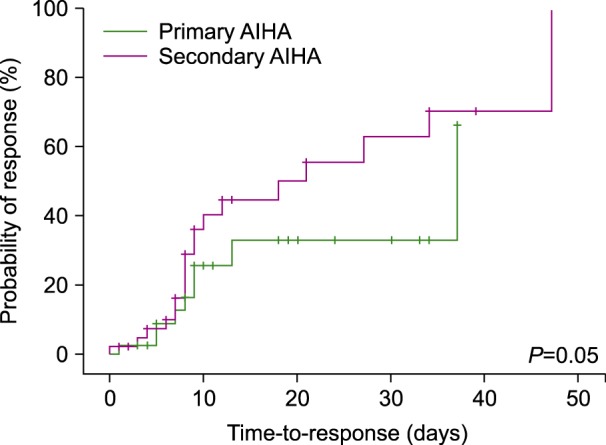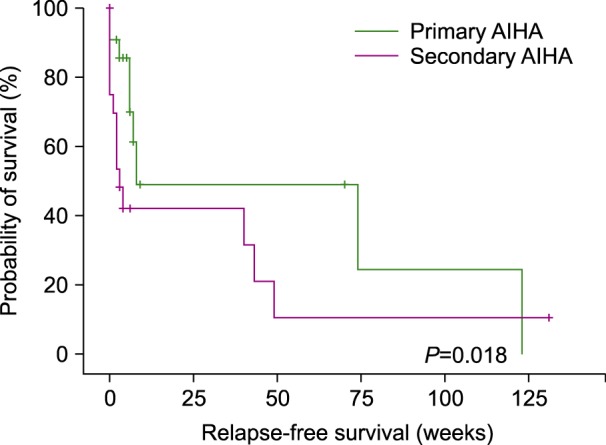Blood Res.
2017 Mar;52(1):44-49. 10.5045/br.2017.52.1.44.
Warm autoimmune hemolytic anemia: experience from a single referral center in Mexico City
- Affiliations
-
- 1Hematology and Oncology Department, Instituto Nacional de Ciencias Médicas y Nutrición Salvador Zubirán, Mexico City, Mexico. retriever_g@yahoo.com
- 2Comprehensive Cancer Center, Médica Sur Clinic and Foundation, Mexico City, Mexico.
- KMID: 2375203
- DOI: http://doi.org/10.5045/br.2017.52.1.44
Abstract
- BACKGROUND
Autoimmune hemolytic anemia (AIHA) is characterized by an autoimmune-mediated destruction of red blood cells. Warm AIHA (wAIHA) represents 60% of AIHA cases and is associated with the positive detection of IgG and C3d in the direct antiglobulin test (DAT). This study aimed to assess the clinical and laboratorial differences between primary and secondary wAIHA patients from a referral center in Mexico City.
METHODS
All patients diagnosed with wAIHA in our institution from January 1992 to December 2015 were included and received corticosteroids as the first-line treatment. We analyzed the response to the first-line treatment, relapse-free survival, and time to splenectomy.
RESULTS
Eighty-nine patients were included. Secondary wAIHA represented 55.1% of the cases. At diagnosis, secondary wAIHA patients showed a DAT mixed pattern more frequently than primary wAIHA patients (36.7 vs. 17.5%, P<0.001). In the survival analysis, patients with secondary wAIHA had a lower time to response (18 vs. 37 days, P=0.05), median disease-free survival (28.51 vs. 50.95 weeks, P=0.018), and time to splenectomy (43.5 vs. 61 wks, P=0.029) than those with primary wAIHA. Due to economic constraints, rituximab was considered as the third-line treatment in only two patients.
CONCLUSION
Secondary wAIHA may benefit from a longer low-dose steroid maintenance period mainly due to its shorter time to relapse and time to splenectomy than primary wAIHA.
Keyword
MeSH Terms
Figure
Cited by 2 articles
-
Treatment of autoimmune hemolytic anemia: real world data from a reference center in Mexico
José Carlos Jaime-Pérez, Patrizia Aguilar-Calderón, Lorena Salazar-Cavazos, Andrés Gómez-De León, David Gómez-Almaguer
Blood Res. 2019;54(2):131-136. doi: 10.5045/br.2019.54.2.131.Splenic myeloid metaplasia in warm autoimmune hemolytic anemia (wAIHA): a retrospective study
Víctor Manuel Anguiano-Álvarez, Alonso Hernández-Company, Nashla Hamdan-Pérez, Daniel Montante-M, Diego A. Zúñiga-Tamayo, Sergio Rodríguez-Rodríguez, Alan Pomerantz, Elena J. Tuna-Aguilar
Blood Res. 2018;53(1):35-40. doi: 10.5045/br.2018.53.1.35.
Reference
-
1. Jaime-Pérez JC, Rodríguez-Martínez M, Gómez-de-León A, Tarín-Arzaga L, Gómez-Almaguer D. Current approaches for the treatment of autoimmune hemolytic anemia. Arch Immunol Ther Exp (Warsz). 2013; 61:385–395. PMID: 23689532.
Article2. Zanella A, Barcellini W. Treatment of autoimmune hemolytic anemias. Haematologica. 2014; 99:1547–1554. PMID: 25271314.
Article3. Berentsen S, Sundic T. Red blood cell destruction in autoimmune hemolytic anemia: role of complement and potential new targets for therapy. Biomed Res Int. 2015; 2015:363278. PMID: 25705656.
Article4. Barros MMO, Blajchman MA, Bordin JO. Warm autoimmune hemolytic anemia: recent progress in understanding the immunobiology and the treatment. Transfus Med Rev. 2010; 24:195–210. PMID: 20656187.
Article5. Bass GF, Tuscano ET, Tuscano JM. Diagnosis and classification of autoimmune hemolytic anemia. Autoimmun Rev. 2014; 13:560–564. PMID: 24418298.
Article6. Roumier M, Loustau V, Guillaud C, et al. Characteristics and outcome of warm autoimmune hemolytic anemia in adults: New insights based on a single-center experience with 60 patients. Am J Hematol. 2014; 89:E150–E155. PMID: 24847759.
Article7. Naik R. Warm autoimmune hemolytic anemia. Hematol Oncol Clin North Am. 2015; 29:445–453. PMID: 26043384.
Article8. Lechner K, Jäger U. How I treat autoimmune hemolytic anemias in adults. Blood. 2010; 116:1831–1838. PMID: 20548093.
Article9. Barcellini W, Fattizzo B, Zaninoni A, et al. Clinical heterogeneity and predictors of outcome in primary autoimmune hemolytic anemia: a GIMEMA study of 308 patients. Blood. 2014; 124:2930–2936. PMID: 25232059.
Article10. Crowther M, Chan YL, Garbett IK, Lim W, Vickers MA, Crowther MA. Evidence-based focused review of the treatment of idiopathic warm immune hemolytic anemia in adults. Blood. 2011; 118:4036–4040. PMID: 21778343.
Article11. Reynaud Q, Durieu I, Dutertre M, et al. Efficacy and safety of rituximab in auto-immune hemolytic anemia: a meta-analysis of 21 studies. Autoimmun Rev. 2015; 14:304–313. PMID: 25497766.
Article12. Maung SW, Leahy M, O'Leary HM, et al. A multi-centre retrospective study of rituximab use in the treatment of relapsed or resistant warm autoimmune haemolytic anaemia. Br J Haematol. 2013; 163:118–122. PMID: 23909468.
Article13. Birgens H, Frederiksen H, Hasselbalch HC, et al. A phase III randomized trial comparing glucocorticoid monotherapy versus glucocorticoid and rituximab in patients with autoimmune haemolytic anaemia. Br J Haematol. 2013; 163:393–399. PMID: 23981017.14. Barcellini W, Zaja F, Zaninoni A, et al. Sustained response to low-dose rituximab in idiopathic autoimmune hemolytic anemia. Eur J Haematol. 2013; 91:546–551. PMID: 24033754.
Article15. Dierickx D, Verhoef G, Van Hoof A, et al. Rituximab in auto-immune haemolytic anaemia and immune thrombocytopenic purpura: a Belgian retrospective multicentric study. J Intern Med. 2009; 266:484–491. PMID: 19549092.
Article16. Rattarittamrong E, Eiamprapai P, Tantiworawit A, et al. Clinical characteristics and long-term outcomes of warm-type autoimmune hemolytic anemia. Hematology. 2016; 21:368–374. PMID: 27077773.
Article17. Baek SW, Lee MW, Ryu HW, et al. Clinical features and outcomes of autoimmune hemolytic anemia: a retrospective analysis of 32 cases. Korean J Hematol. 2011; 46:111–117. PMID: 21747883.
Article18. Zeerleder S. Autoimmune haemolytic anaemia - a practical guide to cope with a diagnostic and therapeutic challenge. Neth J Med. 2011; 69:177–184. PMID: 21527804.19. Alwar V, Shanthala DA, Sitalakshmi S, Karuna RK. Clinical patterns and hematological spectrum in autoimmune hemolytic anemia. J Lab Physicians. 2010; 2:17–20. PMID: 21814401.
Article20. Berentsen S. Role of complement in autoimmune hemolytic anemia. Transfus Med Hemother. 2015; 42:303–310. PMID: 26696798.
Article21. Prabhu R, Bhaskaran R, Shenoy V, G R, Sidharthan N. Clinical characteristics and treatment outcomes of primary autoimmune hemolytic anemia: a single center study from South India. Blood Res. 2016; 51:88–94. PMID: 27382552.
Article




